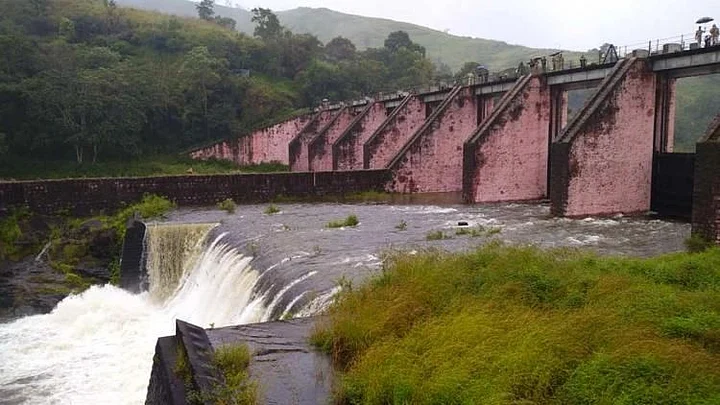The Mullaperiyar dam, which is over a century old, built on the Periyar River in the Idukki district of Kerala has the distinction of being situated in one state but being managed by a neighbouring state — Tamil Nadu. The dam has recently been in the news when its water levels rose, as rains lashed Kerala.
On 23 October, the water level had risen to 136 feet. Kerala CM Pinarayi wrote to Tamil Nadu CM Stalin asking that the water level be regulated to avoid danger to the people living downstream of the dam. Kerala had asked that the water level not cross 136 feet, citing safety concerns. But a Supreme Court ruling allowed the Tamil Nadu government to maintain the water level at a maximum of 142 feet.
On Friday, 29 October, two gates of the dam were opened and the water level was around 138.70 feet. Kerala shifted 339 families located downstream of the dam as the water will make its way to Idukki dam. It was also reported that the Chief Ministers of Tamil Nadu and Kerala would meet to resolve the longstanding issues with the Mullaperiyar dam.
Kerala has been arguing for the dam to be dismantled and a new one be constructed, but Tamil Nadu is opposed to this as it says the water from the dam is used by farmers in several parts of the state.
A Brief History of the Mullaperiyar Dam
The Mullaperiyar dam, located in Kerala’s Idukki district on the Periyar river is a masonry gravity dam and was one of the earliest trans-basin projects to be set up in India. It was commissioned by the British in the erstwhile princely state of Travancore, which was part of the then Madras Presidency.
The dam which is owned, operated and maintained by Tamil Nadu was built between 1887 and 1895 by British engineer John Pennycuick. It is 176 feet high and is 365.7 metres long and can sustain water to a height of 142 feet.
The British built it to divert water to the water-scarce agricultural lands of Madurai and Ramanathapuram in Madras Presidency.
A 999-year lease agreement was signed between Vishaakam Thirunal Rama Varma — Maharaja of Travancore — and the British Secretary of State for India on 29 October 1886.
Nearly 8,000 acres of land situated 155 feet above the Periyar and another 100 acres of land were given on lease to the then Madras Presidency as part of the dam project. The deed permitted water to be diverted from about 648 square kilometres of the river basin that lay above the dam to the then Madras state.
As per the contract, Kerala was entitled to receive a lease amount of Rs 40,000 per annum which was to be deducted from the tribute payable by the Travancore state to the British.
After Independence from the British, Kerala was formed in 1956 by the States Reorganisation Act, the new state government said that the earlier agreement which had been signed between British Raj and Travancore agreement was invalid and needed to be renewed.
In 1959, Tamil Nadu started to generate power using the dam-waters without prior consent from Kerala. Later, a hydel-power project was commissioned in 1965 with four units of 35 megawatts each.
The original contract was then amended in 1970 to ratify the Periyar hydroelectric project with effect from 1954. The lease amount was raised to Rs 30 per acre from the previous Rs 5 per acre, with a provision to review this every 30 years.
Kerala also got exclusive fishing rights in addition to the revenue generated from wildlife tourism in the Periyar National Park located in the reservoir area. This was apart from the annual lease rent coupled with royalty from power generation that was to be paid by Tamil Nadu.
Meanwhile in 1961, there were questions regarding the safety of the Mullaperiyar dam after there were floods in the region. Fast forward to 1998, the Tamil Nadu government wanted to raise the height of the water level, but Kerala opposed it.
In 2006, the Supreme Court allowed Tamil Nadu to raise the water level from 136 to 142 feet. A three-member supervisory committee was appointed by the Union government and Supreme Court for periodic inspection of the dam.
In response, Kerala constituted the Dam Safety Authority. In 2010, the AS Anand Committee was set up by the Supreme Court to look into all the issues of Mullaperiyar dam, and both states could nominate a member each.
However, in 2012, the Supreme Court rejected Kerala's plea to bring on record data from its committee of experts from IIT Delhi and IIT Roorkee, to counter the expert committee's report citing the dam structure as safe.
Further, in 2014, the Supreme Court squashed Kerala law on the Mullaperiyar Dam that said that the water level cannot be increased above 136 feet. It allowed water level to be raised to 142 feet with a provision for up to 152 feet after requisite strengthening measures are made.
On 27 October 2021, as heavy rains lashed Kerala, the state government asked that Tamil Nadu maintain the water levels in the dam at 137 feet even as the water rose to 137.60 feet.
Tamil Nadu, however, said that the water should be retained in the dam till it reached 142 feet. Tamil Nadu CM Stalin wrote to CM Pinarayi assuring him Tamil Nadu will ensure the interests of both states and that people will be safeguarded.
On 28 October it was reported that the Kerala government submitted a note to the Supreme Court saying that the dam must be decommissioned and a new dam built. In its submission, it cited the age of the dam, its limited storage capacity and large catchment area.
(Published in an arrangement with The News Minute)
(At The Quint, we question everything. Play an active role in shaping our journalism by becoming a member today.)
